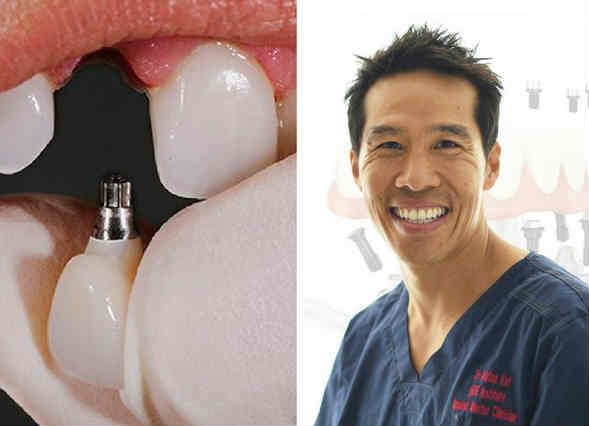Of course, that failure rate talks about the dental implant industry as a whole. Amazingly, aside from the 10 to 15 dominant players, there are around another 200 brands of dental implants out there. Along with such breadth of product, there is a breadth in the skills and experience of the dentists fitting the implants. Great dentists have very low failure rates.
In Australia, the dental implant field is roughly similar to the USA’s, just considerably smaller.
Advanced Dental Artistry actually sees more cases of dental implant failure than you’d expect. Unlucky patients looking for a solution for failure of implants fitted elsewhere, come to us based on our reputation as a reliable dentistry leader.
The types of dental implant failures
Without getting too technical, there are three ways dental implants can fail.
- Biomechanical failures – when the implant breaks or fractures at the implant site.
- Cosmetic failure – when the implant’s appearance changes (such as staining) or the patient is unsatisfied with the result
- Gum and bone infections – where there are complications between the patient’s own tissue and the structure of the implants.
While resolving the others is often quite straightforward, the third kind covers the so-called peri-implant diseases. They involve medical complications and are the type of dental failure we’re going to look at in more depth here.
Peri-implant diseases
Roughly akin to periodontal diseases for natural teeth, peri-implant disease can occur in either of the major stages of the dental implant procedure.
Primary infections happen after the anchoring implant is placed but before it is loaded with a bridge or crown. This is in the first 3 to 6 months. Sometimes called “rejection”, primary peri-implant diseases occurs when the jawbone doesn’t grow into the implant (called osseointegration). While pain is an occasional symptom of rejection, more often we see swelling and redness of the gum. This happens soon after the implant has been placed and hasn’t had a chance to heal.
Secondary infection (or secondary failure) occurs after the implants have been loaded with the new teeth. This sort of failure occurs 3 to 6 months after the implant has been placed. If the problem is an inflammation and bleeding of the gum through a bacterial infection, it is mucositis. A more severe problem can be peri-implantitis, which has many of the same symptoms but also involves the jawbone. If there is bone loss around the tooth which progresses past a certain point, the entire implant can fail.
How peri-implant diseases occur
Both the patient and their dentist can have a role in creating the conditions that result in peri-implant diseases. For the dentist, the crown or bridge they design for their patient is crucial. There are many points to consider:
- Is it cleanable?
- Is the contact point between implant and teeth good enough that food can’t get in?
- Is the implant screen actually retained?
- Has cement been left around the implant?
- Has the implant been placed correctly?
- Was the dentist experienced with the brand of implant they used?
They’re questions a patient cannot answer, but it is good to know some of peri-implant diseases the dental work can lead to. As for things a patient can control, the overwhelmingly important things are health and hygiene. At Advanced Dental Artistry we’ve found dental implant failures are more common among patients who:
- have cardiovascular problems
- are smokers
- have diabetes
- are taking antidepressants
- have poor general health.
General health aside, a patient’s cleaning and maintenance routines are vitally important in preventing dental failure. This is even more important if their implants are associated with or next to natural teeth.
Treating dental implant failure
Advanced Dental Artistry’s lead dentist Dr Adrian Kat points out that while a great deal of research has been done, there is not a lot of consensus on how dental implant failure should be treated. Therefore, his advice is that the signs of dental failure must be picked up early.
If mucositis is detected, the treatment begins with the dentist examining the area for any bleeding this is followed by an X-ray to check to check for bone loss. They will also remove the superstructure as in many cases cement or debris around the crown is the cause. The dentist will also conduct a full clean of the area.
In more advanced cases, access surgery may be required and possibly grafting of soft tissue to improve the gums. Following that, the crown itself may have to be replaced if it was not correctly fitted originally.
If the patient has a case of peri-implantitis, it means the bone around the implant is involved. The condition at first appears similar to mucositis, however any underlying issues will be revealed by X-ray.
Following the scans, the dentist will remove the superstructure to check and clean the implant and drain the infection. Whether surgery is required depends on bone loss around the tooth. This surgery can be a relatively minor “resection” or a more involved bone graft.
You shouldn’t have to deal with dental implant failure
As well as the very small failure rate we discussed earlier, this article has looked at how a dental implant procedure that has not had perfect results can still be stopped from becoming implant failure.
Like so much in medicine, dental implant problems are much easier to treat if detected as early as possible. In the early stages when it is mainly just the gums involved, it is must easier to treat. Once an infection spreads to bone it’s still not too late to get a simple and effective solution.
This article is all about the usual reasons the tiny percentage of implants fail. Of course, overwhelmingly, people who get dental implants have no problems at all. For them everything goes to plan, and 3 or 5 or 10 years later their implants still look and function like natural teeth. It’s the result every dentist and patient wants.
Add: Published on March 22th 2018, last reviewed on October 6th 2020

